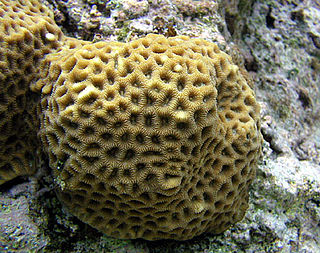
Brain coral is a common name given to various corals in the families Mussidae and Merulinidae, so called due to their generally spheroid shape and grooved surface which resembles a brain. Each head of coral is formed by a colony of genetically identical polyps which secrete a hard skeleton of calcium carbonate; this makes them important coral reef builders like other stony corals in the order Scleractinia. Brain corals are found in shallow warm water coral reefs in all the world's oceans. They are part of the phylum Cnidaria, in a class called Anthozoa or "flower animals". The lifespan of the largest brain corals is 900 years. Colonies can grow as large as 1.8 m (6 ft) or more in height.

Acropora is a genus of small polyp stony coral in the phylum Cnidaria. Some of its species are known as table coral, elkhorn coral, and staghorn coral. Over 149 species are described. Acropora species are some of the major reef corals responsible for building the immense calcium carbonate substructure that supports the thin living skin of a reef.

Mussidae is a family of stony coral in the order Scleractinia. Following a taxonomic revision in 2012, the family is now restricted to species found in the Atlantic Ocean, with Pacific species transferred to the new family Lobophylliidae. Many species are referred to as brain coral because their generally spheroid form and grooved surface resembles the convolutions of a brain.

Montipora is a genus of Scleractinian corals in the phylum Cnidaria. Members of the genus Montipora may exhibit many different growth morphologies. With eighty five known species, Montipora is the second most species rich coral genus after Acropora.

Duncanopsammia is a monotypic genus of stony corals. It is represented by the single species, Duncanopsammia axifuga, commonly called whisker coral, duncanops coral, or simply duncan coral. Individual polyps are fairly large with round skeletal bases (corallites) 10–14 millimetres (0.39–0.55 in) in diameter and larger central discs from which multiple tentacles radiate; the polyps form a structure branching at irregular intervals to form a large colony.

The Fungiidae are a family of Cnidaria, commonly known as mushroom corals or plate corals. The family contains thirteen extant genera. They range from solitary corals to colonial species. Some genera such as Cycloseris and Fungia are solitary organisms, Polyphyllia consists of a single organism with multiple mouths, and Ctenactis and Herpolitha might be considered as solitary organisms with multiple mouths or a colony of individuals, each with its separate mouth.

Pocillopora is a genus of stony corals in the family Pocilloporidae occurring in the Pacific and Indian Oceans. They are commonly called cauliflower corals and brush corals.

Cycloseris is a genus of solitary disc corals in the family Fungiidae. They are found in the Indo-Pacific. They inhabit the lower reef slopes, and the areas between reefs with soft sediments. They tolerate turbid waters.
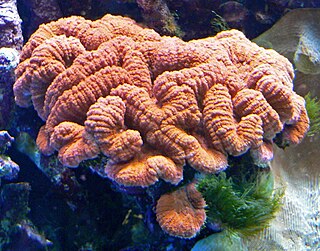
Lobophyllia, commonly called lobed brain coral or lobo coral, is a genus of large polyp stony corals. Members of this genus are sometimes found in reef aquariums.

Galaxea is a genus of colonial stony corals in the family Euphylliidae. Common names include crystal, galaxy, starburst and tooth coral. They are abundant on reefs in the Indo-Pacific region and the Red Sea. They are found in water less than 20 metres (66 ft) deep and favour turbid sites. They are sometimes kept in reef aquaria.

Poritidae is a family of stony corals. Members of the family are colonial hermatypic (reef-building) corals. They are variable in size and form but most are massive, laminar or ramose as well as branching and encrusting. The corallites are compact with very little coenosteum covering the skeleton. The walls of the corallites and the septa are porous. J.E.N. Veron considers the family is not a natural grouping but is a miscellaneous collection of genera that do not fit well elsewhere.

Alveopora is a genus of colonial stony corals in the family Acroporidae. Members of this genus are native to the Indo-Pacific region and are often found on reef slopes in turbid water. They are generally uncommon.

Lobophylliidae is a family of large polyp stony corals. The family was created in 2009 after a revision of the "robust" families of Faviidae, Merulinidae, Mussidae and Pectiniidae, which had been shown to be polyphyletic. The family Lobophylliidae was formed out of the Indo-Pacific species that had traditionally been included in Mussidae, and some of the species which had previously formed Pectiniidae, the remaining species from Pectiniidae having been merged into Merulinidae. The type genus is Lobophyllia.

Merulinidae is a family of reef-building stony corals.
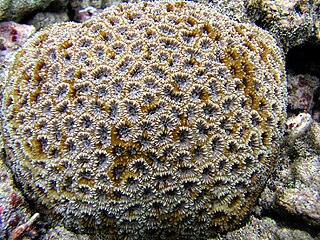
Dipsastraea is a genus of stony corals in the family Merulinidae. Members of this genus are native to the Indo-Pacific region. They are zooxanthellate corals.

Oulophyllia is a genus of stony corals in the family Merulinidae. Members of this genus are native to the tropical western and central Indo-Pacific region.
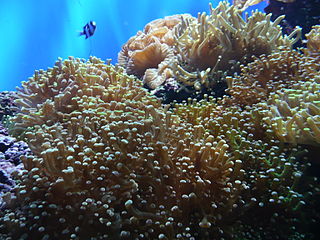
Euphylliidae are known as a family of polyped stony corals under the order Scleractinia.
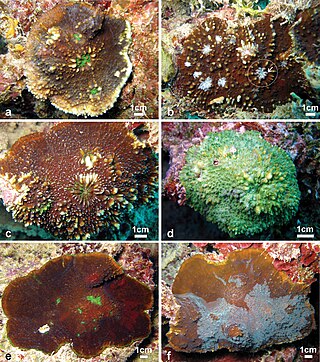
Echinophyllia is a genus of large polyp stony corals. Members of this genus are colonial corals and are generally foliaceous, usually with very thin leaves. They are native to the Indo-Pacific and are sometimes found in reef aquariums.

Goniopora tenuidens is a species of colonial stony coral in the family Poritidae. It occurs in shallow water in the tropical Indo-Pacific region. The International Union for Conservation of Nature has assessed its conservation status as being of "least concern".

Goniopora columna is a species of colonial stony coral in the family Poritidae.




















